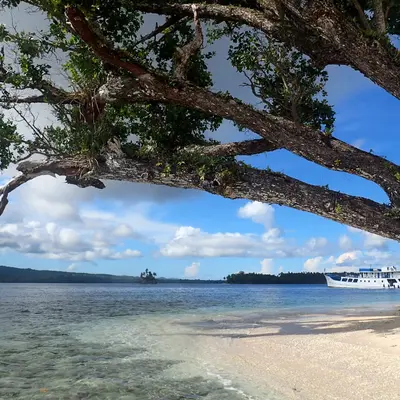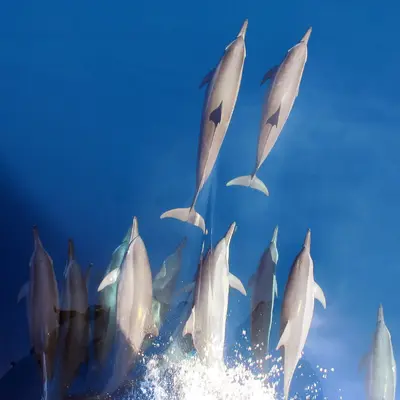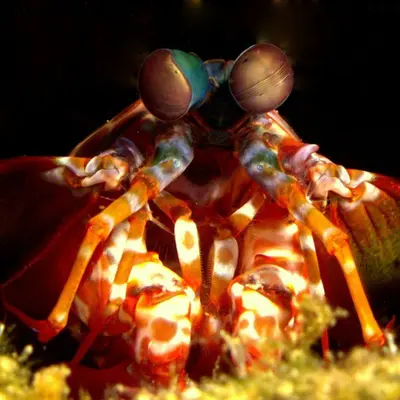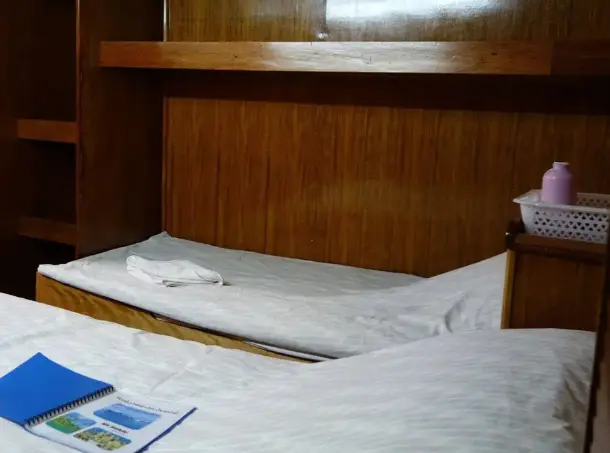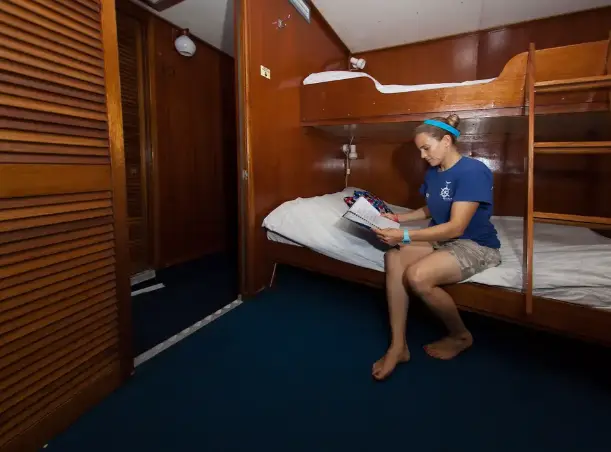The dive routes of the Emperor Bilikiki lead through the three most important island groups of the Solomon Islands: the Florida Islands, Russell Island and the impressive Marovo Lagoon.
Each region offers a wide range of different dive sites - from colourful coral gardens and wrecks to walls and macro hotspots. Thanks to this diversity, every safari is a varied experience for beginners and experienced divers alike.
The ship is in operation from March to December. Guests are looked after by a professional team of 11 experienced crew members and two dedicated on-board managers, who work together to ensure a smooth operation and an all-round successful holiday.
This website uses Google Maps to embed map material. Please note that your personal data may be collected in the process. To view the Google Maps map, please agree that it is loaded from the Google server.
The Emperor Bilikiki was the first luxury, full-service liveaboard to offer diving holidays in the Solomon Islands - and is still considered one of the best vessels in the region. Specially designed for the conditions of the South Pacific, she impresses with her comfort, space and first-class organisation, which is why many guests describe her as one of the most comfortable liveaboards they have ever travelled on.
There are 10 spacious cabins on board, all equipped with en-suite bathrooms and air conditioning. In addition, guests can expect spacious sun decks, a cosy lounge with seating and a bar - ideal for relaxing after an eventful day of diving.
The Emperor Bilikiki is the perfect choice for divers who want to discover the unspoilt beauty of the Solomon Islands while enjoying the highest level of comfort, excellent service and a family atmosphere.
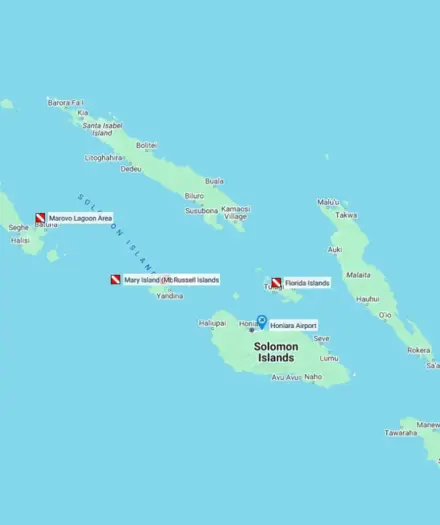
As one of the few liveaboards to explore the Solomon Islands, Bilikiki offers an exclusive exploration of this beautiful and fascinating country
- Abundant and diverse marine life, from sharks and eagle rays to pygmy seahorses.
- Fascinating wrecks from the Second World War include an old American base, a bombed Japanese cargo ship and a Japanese seaplane "Mavis" that remains impressively intact.
- A wide range of diving experiences including muck, walls, caves, coral gardens, wrecks, marine mounts and diving to the soundtrack of an underwater volcano.
- Visit the surrounding villages to see the traditional way of life, sing and dance along and buy traditional carvings.
- Route description
In the centre of the South Pacific, the Solomon Islands are part of the Coral Triangle and home to some of the best - and least visited - dive sites in the world. - The beauty of sailing Emperor Bilikiki is that no two voyages are the same. There is no set itinerary as we head for the best sights at the best times. Wherever the journey takes you, you are guaranteed exceptional diving experiences.
- Visiting places like the Russell Islands, Florida Islands and Marovo Lagoon, you'll be immersed in so many sensory experiences, from stunningly beautiful corals to mesmerising war relics, cave dives and jungle-covered dives with marine life ranging from massive to macro.
- You can dive in Kicha - where friendly batfish follow divers while giant bumphead parrotfish feed on coral - all the while listening to the sounds of the underwater volcano Kavachi.
- There's Karumolun Point, where the local chief has banned all fishing for years and created a protected marine area that will blow you away with the diversity of life and beauty all around.
- And of course there is Mary Island. This is the place often referred to as the 'best dive of a trip', where we often stay all day to enjoy the schools of fish, sharks, turtles and bumphead parrotfish.
- In modern history, the Solomon Islands experienced some of the fiercest fighting in the Pacific during the Second World War. There are some war relics both on land and at sea and we take you on some incredible wreck dives.
- We also take you off the water to experience life in the Solomon Islands. With around 990 islands inhabited by only 700,000 people, the ways have hardly changed and the majority of the population still live in traditional, community-based villages away from the modern world. Local culture is a must.
- So why not go to a place where few other divers have ventured and have one of the best and most diverse experiences of your life?
Example of an itinerary
Day 1 - Check in
Upon arrival at the airport, guests will be greeted by a representative in uniform holding a sign for the boat trip. The meeting point is at the main exit, after baggage collection.
The aim is to have all guests on board by 16:00 and to leave the harbour as soon as everyone is on board. A safety briefing will take place on the boat, followed by an introduction to the crew, filling out dive papers, cabin assignment and a boat briefing.
Day 2 - 10
Enjoy 4-5 dives per day, including a night dive.
Divers of all experience levels are welcome and there are exceptional snorkelling opportunities. There is no minimum number of dives required to participate, but participants must be certified divers.
Day 11
Settlement of accounts begins at 6:30am.
Departure is scheduled for 8:00 am.
The last dive will take place on the penultimate day of the trip. Divers are advised to wait 24 hours after the last dive before flying.
Sample itineraries and maps are for illustrative purposes only. The exact route and locations visited may change depending on local regulations, guest experience, weather and logistics and are at the captain's discretion.
All our departures are designed to be compatible with inbound and outbound flights, so overnight stays are not usually required. We will pick you up at the airport and take you to the ship or, if your flight is before boarding time, to a nearby hotel where you can relax. On the last day you usually have a couple of hours to look around the city before we take you back to the airport, many people opt for one of the interesting World War 2 history tours in Honiara. Of course, not all flights arrive and depart from all ports of entry on our charter dates, so depending on when you choose to fly with an overnight stay, this may be necessary.
Cabins
- 1 double or 2 single beds
- En-suite bathroom
- adjustable air conditioning
- max. 2 guests
The cabins are approximately 9 square metres in size and each has its own bathroom with shower and air conditioning. Eight cabins are equipped with a double bed and an additional bunk bed, while two cabins have two single beds without bunk beds. Please indicate your preferred bed configuration when booking. The choice of bed is subject to availability. Hand and face towels, shampoo and soap are provided for each guest. A hairdryer is available on request.
Included: VAT, harbour fees, national park fees, airport transfers, tea & coffee, drinking water, snacks, full board (all meals), nitrox, dive packages, kayaks, shore excursions, towels for use on deck, cabin towels, complimentary toiletries, Wi-Fi.
Required extras: Visa and fees.
Optional extras: gratuities, alcoholic drinks, soft drinks, equipment hire, Nitrox course, diving courses.
Prices for rental equipment
Rental equipment is available on this ship. Please indicate on the booking form what you need. Details below of what is included and the additional prices.
- 15 litre tanks 15 USD per day
- Regulators 13 USD per day
- BCD 13 USD per day
- Fins 10 USD per day
- Mask 10 USD per day
- Signal buoy Included
- Torch 15 USD per day
- Dive computer 15 USD per day
- Full equipment (with: regulator, BCD, buoy, dive computer) 27 USD per day
- Air temperature: Stable all year round between 26.5 °C and 27.0 °C.
- Water temperature: Constantly warm between 28.5 °C and 29.0 °C, ideal for diving.
- Precipitation: Highest in February (280 mm) and January (250 mm); lowest in August (110 mm).
The Solomon Islands are an island nation in the South Pacific, east of Papua New Guinea and north-east of Australia. It consists of around 990 islands, of which around 350 are inhabited. The most important island groups:
Guadalcanal (with capital Honiara
New Georgi
Santa Isabel
Rennell & Bellona
Russell Islands
Florida Islands
The islands are located in the Coral Triangle, one of the world's most biodiverse marine ecosystems.
Population
Around 740,000 inhabitants, mainly living in rural coastal regions.
The population is ethnically predominantly Melanesian, with small Polynesian and Micronesian minorities.
There are many traditional tribal cultures with their own languages (over 70 indigenous languages).
English is the official language, but Pijin (Solomon Creole) is used in everyday life.
Religions
Over 90 % of the population are Christians, mainly:
Anglicans
Catholics
Evangelical Free Churches
Religious life is deeply embedded in everyday life, often combined with elements of traditional spirituality (e.g. ancestor worship).
Economic situation
The Solomon Islands are one of the least economically developed countries in the region. Most important sectors:
Agriculture (coconut, cocoa, palm oil)
Fishing
Timber export (partly controversial due to environmental destruction)
Tourism (still in its infancy, but growing)
Infrastructure and transport connections are often inadequate - many places can only be reached by boat or small aeroplane.
Significance for eco & diving tourism
The Solomon Islands are considered one of the best-kept secrets in the diving sector. Due to their remoteness, the reefs are largely untouched.
Intact coral reefs
Wrecksfrom the Second World War (e.g. in Iron Bottom Sound)
Cliffs, caves, macro spots and big fish sightings
The focus is on small-scale, sustainable tourism with close involvement of the local communities.
Economic impact of the diving industry
Still a relatively small sector, but important for certain island groups (e.g. Gizo, Munda, Tulagi, Uepi).
Jobs in resorts, diving centres, boat services, crafts
Promotion of marine conservation projects
Investments in education, local infrastructure and community projects
Many diving resorts work closely with the villages (e.g. compensation for reef use, school projects).
Challenges:
Logistical difficulties & high costs for international travel
Limited medical care and emergency infrastructure
Danger from climate influences, coral bleaching and unsustainable fishing
Why the Solomon Islands are a favourite destination for divers
Unspoilt, remote reefs without mass tourism
Excellent visibility & great biodiversity
World-class wreck diving - especially in the region around Guadalcanal ("Iron Bottom Sound")
Mix of big fish, macro and topography - steep walls, caves, mangroves
Authentic cultural experiences - traditional villages, dance, handicrafts
Small, exclusive eco-resorts - ideal for individual travellers and underwater photographers
Best time to visit: April-November (drier, more stable sea)

